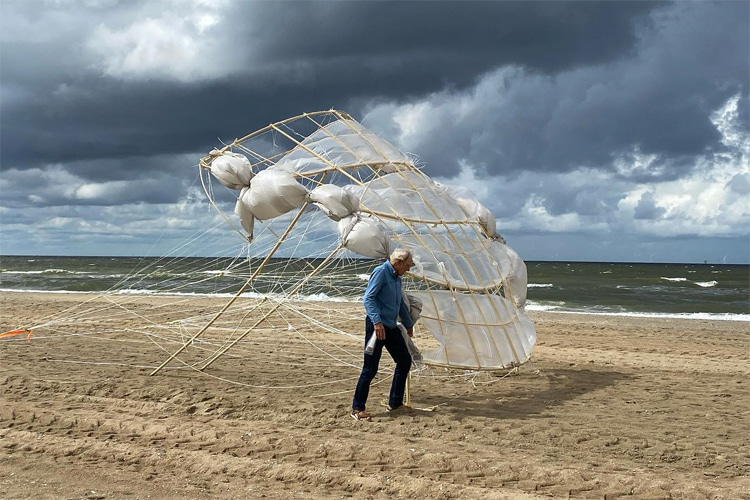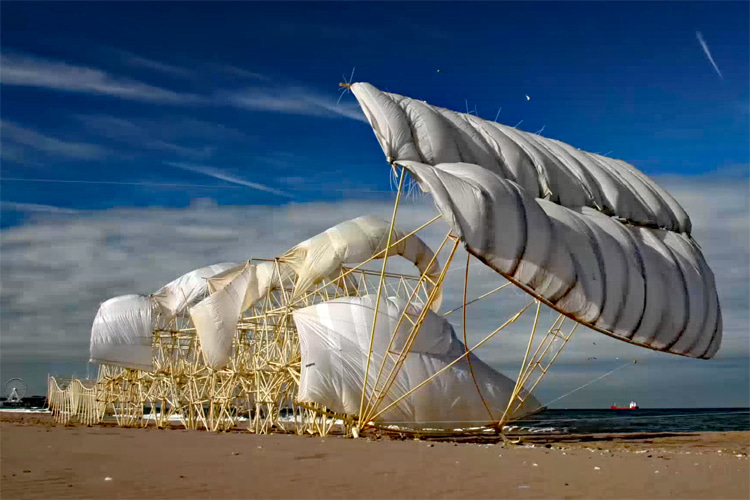On the windy beaches of the Netherlands, a mesmerizing sight catches the eye. It's called "Animaris Rex," an 18-meter-long kinetic sculpture that seems to have a life of its own.
The latest creation by renowned Dutch artist Theo Jansen, known for his wind-powered Strandbeest sculptures, is making waves in the art world.
Jansen's newest artwork isn't just a single entity but a group working in harmony.
He describes the "Animaris Rex" as "a herd of beach animals" that band together to withstand the mighty storms that often sweep the Dutch coast.
Alone, each unit might be toppled by strong winds, but united, their collective strength significantly increases their odds of weathering the tempests.
The vision behind Jansen's Strandbeest creations traces back to the 1980s when he imagined skeletal structures roaming the beaches, collecting sand.
Originally, he hoped these mobile sculptures could help raise sand dunes, bolstering the Netherlands' age-old defenses against rising sea levels.
While the primary purpose of the Strandbeests has evolved over time, their captivating movement and intricate design continue to enchant observers.

Delicate and Complex "Beests"
Constructed primarily from plastic PVC tubing, PET bottles, and other lightweight materials, these "beests" showcase a masterful blend of artistry and engineering.
The rhythmic tapping of their legs and the flapping of sails against the wind are a treat for both the eyes and ears.
"Animaris Rex," in particular, stands out due to its impressive length - a full five meters longer than the largest Tyrannosaurus Rex ever discovered.
Jansen's dedication to his craft has been unwavering for almost three decades.
Since 1990, he has been engrossed in designing these wind-propelled beach animals.
Each new version, including the "Animaris Rex," highlights the artist's growing expertise and commitment to refining his designs.
The "Animaris Rex" is also noteworthy for its interconnected design.
Jansen has ingeniously linked several walking units or "Ordissen" to function in unison.
This latest creation can be seen gliding gracefully along the world's beaches, with every unit playing a crucial role in the collective movement.
Theo Jansen: A Kinetic Sculptor
Theo Jansen is a Dutch artist and kinetic sculptor best known for his remarkable wind-powered creations called "Strandbeests" (translated as "Beach Animals").
Born in 1948 in The Hague, Netherlands, Jansen initially studied physics at the University of Delft but eventually transitioned to art.
His background in both art and science has greatly influenced his work.
The Strandbeests reveal Jansen's ingenuity and creativity.
Made from lightweight materials like PVC tubes, these large, skeletal creatures are designed to move autonomously, driven solely by the power of the wind.
Over the years, Jansen has refined their designs, incorporating evolutionary principles.
His goal has been to create increasingly sophisticated "animals" that can adapt and survive on beaches.
They are often equipped with mechanisms that allow them to sense and avoid obstacles, store wind energy, and even "sense" water.
Jansen's work blurs the lines between art, engineering, and biology.
He often speaks about his creations in terms of "evolution" and "life forms," underscoring his philosophical exploration of life, movement, and survival.
The Strandbeests have garnered international attention and admiration, leading to numerous exhibitions, documentaries, and public performances.
In essence, Theo Jansen is a visionary artist who fuses science and art to challenge our perceptions of life, movement, and the possibilities of human creativity.
